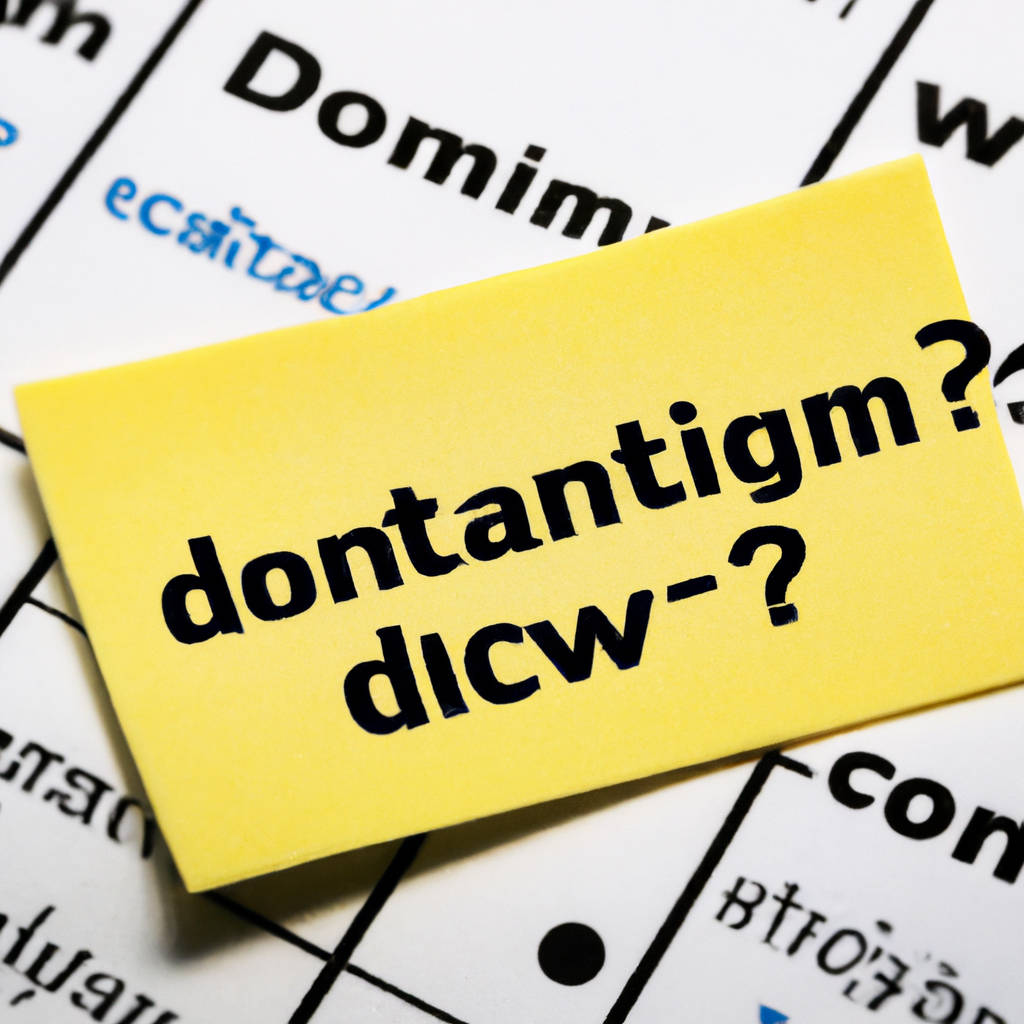Crafting the ideal short domain for your brand is an art form that requires precision, creativity, and strategic thinking. It’s the digital address that represents your brand in the online world, which is often the first touch point for potential customers. Therefore, it’s essential that your domain name is concise, easy to remember, and aligns perfectly with your brand identity. Making it short is beneficial because it’s easier for people to remember and less prone to mistakes when typing it into a web browser.
However, it’s not just about brevity. The domain name needs to encapsulate the essence of your brand, be intuitive, and resonate with your target audience. It should also be unique, so it cannot be easily confused with other brands. To achieve this, you could consider using industry keywords, acronyms, or even inventing a new word. Furthermore, it’s recommended to use a reliable domain registrar and choose an extension (.com, .net, .org, etc.) that suits the nature of your business. Remember, your domain name is a powerful tool for brand recognition and credibility in the digital landscape, hence the importance of crafting it with care and strategic intent.

Short Domain Benefits
Short domain names are highly desirable in the digital world due to their numerous advantages. A key benefit of a short domain name is its memorability. Given the inundation of information on the internet, a concise, easy-to-remember domain name can significantly increase the chances of potential visitors returning to your site. It’s also easier to share verbally, making it an excellent tool for word-of-mouth marketing.
Another advantage is the influence on Search Engine Optimization (SEO). While a short domain name itself does not directly improve SEO, it indirectly influences user behavior metrics like CTR (Click Through Rate), which can affect search rankings. A short, catchy, and relevant domain name can attract more clicks, leading to better online visibility.
Furthermore, having a short domain name also enhances the aesthetic appeal and professionalism of your website. It helps in creating a strong, clear, and concise brand image. A shorter domain name also reduces the chances of typos or spelling mistakes when users try to access your site, thereby improving user experience.
Moreover, short domain names are ideal for mobile users. Given the increasing use of smartphones for internet surfing, a short domain is easy to type on a small keyboard and fits neatly within the width of a mobile screen.
In the realm of email, a short domain name can also make business communication easier and more professional. It makes email addresses shorter, easier to remember, and less prone to errors.
In conclusion, a short domain name can serve as a powerful tool in enhancing online visibility, improving user experience, branding, and mobile and email usability. Despite these benefits, it’s important to remember that the domain name should still accurately represent your brand or business. Therefore, while keeping it brief, make sure it is meaningful, relevant, and aligns with your brand identity.
Authoritative
Authoritative refers to a demeanor or behavior that commands respect, obedience, and compliance. It often relates to individuals in leadership positions such as managers, teachers, or parents, who guide and influence others through their compelling presence, wisdom, and knowledge. An authoritative figure typically exhibits confidence, decisiveness, and a high level of expertise in a specific area, making them a trusted source of guidance and direction. It is important to note that being authoritative should not be confused with being authoritarian.
The former promotes an environment of mutual respect and open communication, while the latter may rely on strict control and one-way communication. The effectiveness of an authoritative style in leadership or parenting, for instance, lies in its balanced approach. It fosters a sense of autonomy, accountability, and competence among those under its influence, while still providing clear standards, expectations, and boundaries. This approach can motivate individuals to perform at their best, not out of fear or coercion, but out of respect and intrinsic motivation. It can also equip them with problem-solving skills, emotional intelligence, and a positive attitude towards challenges. Being authoritative, therefore, is not about enforcing power or control, but about inspiring others to grow, learn, and excel in their respective fields or roles.

Fewer Typos
The importance of fewer typos in any written communication cannot be overstated, as they can greatly influence the reader’s perception of the author’s competence and attention to detail. A document filled with typographical errors might give an impression of carelessness or lack of professionalism, which could be detrimental in a professional setting. In academia, such mistakes could lead to misinterpretation of data or research findings, thereby affecting the credibility of the work. In the realm of digital content, a multitude of typos may impact the website’s Search Engine Optimization (SEO) ranking negatively, as search engines prioritize high-quality, error-free content.
Furthermore, in the publishing industry, a book or an article with numerous typos can be off-putting to readers, diminishing their reading experience and possibly leading to negative reviews. Therefore, it is essential to strive for fewer typos in all written communication. This can be achieved through thorough proofreading, utilizing grammar and spell-check tools, and even seeking professional editing services when necessary. Additionally, honing one’s writing skills through regular practice and education can also contribute to reducing typographical errors over time. Overall, fewer typos can lead to higher quality writing, more positive reader impressions, better professional reputation, and improved SEO ranking, among other benefits.
Enhances Mobile Usability
Enhancing mobile usability is a critical aspect of modern day technology development. It involves optimizing interfaces, applications, and platforms with the objective of making them more user-friendly, efficient, and accessible. The primary focus is on creating a seamless interaction and navigation experience for users, which significantly impacts user satisfaction and engagement. A mobile application or site that offers an exceptional usability experience will most likely retain more users compared to one that doesn’t.
For an application to be considered as having high mobile usability, it has to exhibit certain characteristics. First, it should be designed with the user in mind. This includes ease of understanding, simplicity, and intuitiveness. The design should also take into consideration various user abilities and preferences, making it accessible to a wide range of users. The application should also be responsive, offering quick load times and immediate feedback to user actions.
Moreover, enhancing mobile usability involves ensuring that the application or site is compatible across multiple mobile devices and platforms. This guarantees that no matter the device a user chooses, they can still enjoy a fantastic user experience. Lastly, the application should provide value to the user. This could be in the form of relevant content, useful features, or solving a problem for the user.
In conclusion, enhancing mobile usability is not a one-time process, but a continuous one. It requires regular user feedback, testing, and updating to meet the changing needs and expectations of the users. By prioritizing mobile usability, companies can significantly improve their user engagement, satisfaction, and ultimately their bottom line.

Short vs. Long Domains
Choosing between short and long domains is an essential aspect of website design and online branding that cannot be overlooked. The decision is not simply a matter of personal preference, but it carries significant implications for online visibility, memorability, and user experience. Short domains, typically less than six characters, are often coveted for their brevity and simplicity. They are easier to recall, type, and share, which can be beneficial in marketing, search engine optimization (SEO), and overall brand recognition. However, they are often more expensive and harder to obtain due to their high demand and limited availability.
On the other hand, long domains, usually exceeding six characters, offer more opportunities for creativity and specificity. They can provide a greater context about the website’s content, purpose, or target audience, which can improve relevance and searchability. Additionally, long domains are generally more affordable and accessible, making them a more practical choice for startups, small businesses, or niche websites. However, they may be more prone to typos and misunderstandings, and they may also appear less professional or trustworthy to some users.
In conclusion, the choice between short and long domains depends on various factors such as the nature of the business, target audience, marketing strategy, and budget. It’s essential to carefully consider these aspects before making a decision, as the domain name can significantly impact the website’s success and online presence. Also, it’s crucial to remember that while the domain length is important, it’s only one aspect of a comprehensive online strategy. Other critical elements include the domain’s relevance, uniqueness, and credibility, among others.
Choosing the Right Domain Extension
Selecting the most suitable domain extension for your website is a critical decision that can significantly impact your online presence. This choice is more than just a technical aspect; it’s an integral part of your brand image, search engine optimization, and overall online reputation. A domain extension, also known as a top-level domain (TLD), is the suffix at the end of a web address like .com, .org, .net and so on. The .com extension is the most popular and widely recognized, hence, businesses often lean towards it for a global reach. However, the market is becoming more diverse and new generic top-level domains (gTLDs) like .shop, .blog, .app are gaining traction.
They provide more specificity and availability compared to traditional TLDs. There are also country code top-level domains (ccTLDs) like .us, .uk, .au which are great for businesses targeting specific geographical regions. Therefore, when deciding on the right domain extension, consider your business objectives, target audience, and availability of your preferred name. It is also advised to research potential implications on SEO and user perception. Remember that your domain name and extension are a reflection of your brand in the digital world and hence, the decision should align with your overall branding strategy. In conclusion, selecting the right domain extension is a careful balance of many factors that requires thoughtful consideration and strategic planning.

Tips for Short Domain Selection
Choosing the right short domain name for your website can have a significant impact on your online presence. It not only represents your brand, but can also influence SEO, and therefore, your website traffic. Here are a few tips to guide you in the selection process. Firstly, opt for a name that is relevant to your business or industry. It should be easy to spell, pronounce, and remember, as this aids recall and word-of-mouth referrals. Avoid using numbers and hyphens as they can cause confusion when verbally sharing your domain. Additionally, ensure that the domain name is unique to avoid confusion with other brands. Secondly, consider the domain extension.
While .com is the most popular, there are many other extensions available that might be more appropriate for your website, such as .org for non-profits or .edu for educational institutions. Lastly, conduct thorough research to ensure that your chosen domain isn’t trademarked, copyrighted, or being used by another company. It might be wise to purchase various domain extensions and misspellings related to your brand to protect it from competitors. Utilizing domain selection tools and platforms can also simplify the search and selection process. Keep in mind, your domain name is an investment, so it’s worth taking the time to choose one that will resonate with your target audience and reflect your brand identity effectively.
Domain Registration: Where to Start?
Starting with domain registration can be a daunting task, particularly for those new to the world of websites and online platforms. However, the process is actually quite straightforward and can be broken down into a few simple steps. The first task is to choose an appropriate domain name that reflects your brand or the purpose of your website. This should be unique, memorable, and easy to spell. Once you have chosen your domain name, the next step is to check its availability. You can do this by using a domain name checker, which is a tool provided by most domain registration companies. If your chosen domain name is available, you can proceed with the registration process. If not, you will need to think of an alternative.
The next stage is to select a domain registrar. This is the company that will manage your domain name. There are many to choose from, each with their own pricing structures and additional services. It is important to compare these before making a decision. After selecting a registrar, you proceed to purchase your domain. This normally involves a yearly fee, although some registrars offer long-term contracts. Once purchased, your domain name is yours to use as you wish. Most registrars will provide a control panel where you can manage your domain. Here, you can link it to your website, set up email addresses, and make any necessary changes. Remember, your domain name is a key part of your online identity, so take the time to choose wisely and manage it effectively. Domain registration is the first step towards establishing your presence on the internet, and with the right approach, it can be a straightforward and rewarding process.
